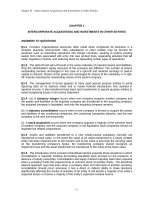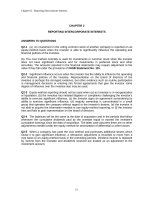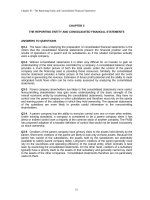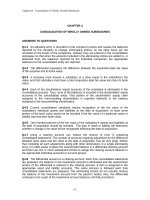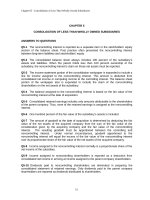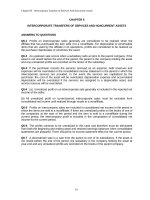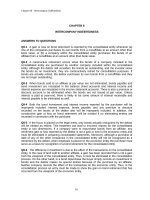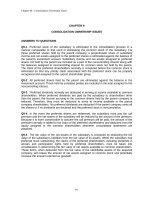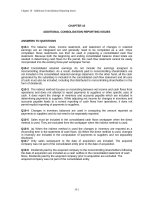Solution manual advanced financial accounting, 8th edition by baker chap004
Bạn đang xem bản rút gọn của tài liệu. Xem và tải ngay bản đầy đủ của tài liệu tại đây (217.94 KB, 58 trang )
Chapter 04 - Consolidation of Wholly Owned Subsidiaries
CHAPTER 4
CONSOLIDATION OF WHOLLY OWNED SUBSIDIARIES
ANSWERS TO QUESTIONS
Q4-1 An adjusting entry is recorded on the company's books and causes the balances
reported by the company to change. Eliminating entries, on the other hand, are not
recorded on the books of the companies. Instead, they are entered in the consolidation
workpaper so that when the amounts included in the eliminating entries are added to, or
deducted from, the balances reported by the individual companies, the appropriate
balances for the consolidated entity are reported.
Q4-2 The differential represents the difference between the acquisition-date fair value
of the acquiree and its book value.
Q4-3 A company must acquire a subsidiary at a price equal to the subsidiary’s fair
value, and that subsidiary must have a total acquisition-date fair value less than its book
value.
Q4-4 Each of the stockholders' equity accounts of the subsidiary is eliminated in the
consolidation process. Thus, none of the balances is included in the stockholders' equity
accounts of the consolidated entity. That portion of the stockholders' equity claim
assigned to the noncontrolling shareholders is reported indirectly in the balance
assigned to the noncontrolling shareholders.
Q4-5 Current consolidation standards require recognition of the fair value of the
subsidiary's individual assets and liabilities at the date of acquisition. At least some
portion of the book value would not be included if the fair value of a particular asset or
liability was less than book value.
Q4-6 One hundred percent of the fair value of the subsidiary’s assets and liabilities at
the date of acquisition should be included. The type of asset or liability will determine
whether a change in its value will be recognized following the date of acquisition.
Q4-7 Using a clearing account can reduce the chance of error in preparing
consolidated statements. The number of accounts requiring adjustment for the difference
between book value and fair value at the date of acquisition may be very large. Rather
than including all such adjustments along with other eliminations in a single eliminating
entry, it is often easier to place the unamortized balance in a differential clearing account
and then use one or more subsequent entries to assign the clearing account balance to
the appropriate individual accounts or account groups.
Q4-8 The differential account is a clearing account. Each time consolidated statements
are prepared, the balance in the investment account is eliminated and the unamortized
portion of the differential is entered in the clearing account. It then is assigned to the
appropriate asset and liability accounts. This same process is followed each time
consolidated statements are prepared. The eliminating entries do not actually remove
the balance in the investment account from the parent's books; thus, the differential
continues to be a part of the investment account balance until fully amortized.
4-1
Chapter 04 - Consolidation of Wholly Owned Subsidiaries
Q4-9 The investment account in the financial statements of the parent company shows
its investment in the subsidiary as a single total and therefore does not provide
information on the individual assets and liabilities held by the subsidiary, nor their relative
values. The existence of a large differential indicates the parent paid well over book
value to acquire ownership of the subsidiary. When the differential is assigned to
identifiable assets or liabilities of the subsidiary, both the consolidated balance sheet and
consolidated income statement are likely to provide information not available in the
financial statements of the individual companies. The consolidated statements are likely
to provide a better picture of the assets actually being used and the resulting income
statement charges that should be reported.
Q4-10 Additional entries are needed to eliminate all income statement and retained
earnings statement effects of intercorporate ownership and any transfers of goods and
services between related companies.
Q4-11 Separate parts of the consolidation workpaper are used to develop the
consolidated income statement, retained earnings statement, and balance sheet. All
eliminating entries needed to complete the entire workpaper normally are entered before
any of the three statements are prepared. The income statement portion of the
workpaper is completed first so that net income can be carried forward to the retained
earnings statement portion of the workpaper. When the retained earnings portion is
completed, the ending balances are carried forward and entered in the consolidated
balance sheet portion of the workpaper.
Q4-12 None of the dividends declared by the subsidiary are included in the
consolidated retained earnings statement. Those which are paid to the parent have not
gone outside the consolidated entity and therefore must be eliminated in preparing the
consolidated statements. Those paid to noncontrolling shareholders are treated as a
reduction in the net assets assigned to noncontrolling interest and also must be
eliminated.
Q4-13 Consolidated net income is equal to the parent’s income from its own
operations, excluding any investment income from consolidated subsidiaries, plus the
income of each of the consolidated subsidiaries, adjusted for any differential write-off.
Q4-14 Consolidated net income includes 100 percent of the revenues and expenses of
the individual consolidating companies arising from transactions with unaffiliated
companies.
Q4-15 Consolidated retained earnings is defined in current accounting practice as that
portion of the undistributed earnings of the consolidated entity accruing to the parent
company shareholders.
Q4-16 Consolidated retained earnings at the end of the period is equal to the beginning
consolidated retained earnings balance plus consolidated net income attributable to the
controlling interest, less consolidated dividends.
Q4-17 The retained earnings statement shows the increase or decrease in retained
earnings during the period. Thus, income for the period is added to the beginning
balance and dividends are deducted in deriving the ending balance in retained earnings.
Because the consolidation workpaper includes the retained earnings statement, the
beginning retained earnings balance must be entered in the workpaper.
4-2
Chapter 04 - Consolidation of Wholly Owned Subsidiaries
Q4-18 An additional eliminating entry normally must be entered in the workpaper to
expense an appropriate portion of the amount assigned to buildings and equipment.
Normally, depreciation expense is debited and accumulated depreciation is credited.
Q4-19 The differential is simply a clearing account used in the consolidation process. If
the differential arises because the fair value of land held by the subsidiary is greater than
book value, the amount assigned to the differential will remain constant so long as the
subsidiary continues to hold the land. When the differential arises because the fair value
of depreciable or amortizable assets is greater than book value, the amount debited to
the differential account each period will decrease as the parent amortizes an appropriate
portion of the differential against investment income.
Q4-20 Push-down accounting occurs when the assets and liabilities of the subsidiary
are revalued on the subsidiary's books as a result of the purchase of shares by the
parent company. The basis of accountability that the parent company would use in
accounting for its investment in the various assets and liabilities is used to revalue the
subsidiary's assets and liabilities; thereby pushing down the parent's basis of
accountability onto the books of the subsidiary.
Q4-21 Push-down accounting is considered appropriate when a subsidiary is
substantially wholly owned by the parent.
Q4-22 When the assets and liabilities of the subsidiary are revalued at the date of
acquisition there will no longer be a differential. The parent's portion of the revised
carrying value of the net assets on the books of the subsidiary will agree with the
balance in the investment account reported by the parent.
4-3
Chapter 04 - Consolidation of Wholly Owned Subsidiaries
SOLUTIONS TO CASES
C4-1 Need for Consolidation Process
After the financial statements of each of the individual companies are prepared in
accordance with generally accepted accounting principles, consolidated financial
statements must be prepared for the economic entity as a whole. The individual
companies generally record transactions with other subsidiaries on the same basis as
transactions with unrelated enterprises. In preparing consolidated financial statements,
the effects of all transactions with related companies must be removed, just as all
transactions within a single company must be removed in preparing financial statements
for that individual company. It therefore is necessary to prepare a consolidation
workpaper and to enter a number of special journal entries in the workpaper to remove
the effects of the intercorporate transactions. The parent company also reports an
investment in each of the subsidiary companies and investment income or loss in its
financial statements. Each of these accounts must be eliminated as well as the
stockholders' equity accounts of the subsidiaries. The latter must be eliminated because
only the parent's ownership is held by parties outside the consolidated entity.
4-4
Chapter 04 - Consolidation of Wholly Owned Subsidiaries
C4-2 Account Presentation
MEMO
To:
From:
Re:
Chief Accountant
Prime Company
, Accounting Staff
Combining Broadly Diversified Balance Sheet Accounts
Many manufacturing and merchandising enterprises excluded finance, insurance, real
estate, leasing, and perhaps other types of subsidiaries from consolidation prior to 1987
on the basis of “nonhomogeneous” operations. Companies generally argued that the
accounts of these companies were dissimilar in nature and combining them in the
consolidated financial statements would mislead investors. FASB 94 specifically
eliminated the exception for nonhomogeneous operations. [FASB 94, Par. 9] FASB 160
affirms the requirement for consolidating entities in which a controlling financial interest
is held.
Prime Company controls companies in very different industries and combining the
accounts of its subsidiaries may lead to confusion by some investors; however, it may be
equally confusing to provide detailed listings of assets and liabilities by industry or other
breakdowns in the consolidated balance sheet. The actual number of assets and
liabilities presented in the consolidated balance sheet must be carefully considered, but
is the decision of Prime’s management.
It is important to recognize that the notes to the consolidated financial statements are
regarded as an integral part of the financial statements and Prime Company is required
to include in its notes to the financial statements certain information on its reportable
segments [FASB 131]. Because of the diversity of its ownership, Prime may wish to
provide more than the minimum disclosures specified in FASB 131. Segment
information appears to be used quite broadly by investors and permits the company to
provide sufficient detail to assist the financial statement user in gaining a better
understanding of the various operating divisions of the company.
You have requested information on those situations in which it may not be appropriate to
combine similar appearing accounts of two or more subsidiaries. The following is a
partial listing of such situations: (a) the accounts of a subsidiary should not be included
along with other subsidiaries if control of the assets and liabilities does not rest with
Prime Company, as when a subsidiary is in receivership; (b) while the assets and liability
accounts of the subsidiary should be combined with the parent, the equity account
balances should not; (c) negative account balances in cash or accounts receivable
should be reclassified as liabilities rather than being added to the positive
4-5
Chapter 04 - Consolidation of Wholly Owned Subsidiaries
C4-2 (continued)
balances of other affiliates, and (d) assets pledged for a specific purpose and not
available for other use by the consolidated entity generally should be separately
reported.
Primary citations:
FASB 94
FASB 131
FASB 160
Secondary sources:
ARB 51
FASB 14
4-6
Chapter 04 - Consolidation of Wholly Owned Subsidiaries
C4-3 Consolidating an Unprofitable Subsidiary
MEMO
TO:
Chief Accountant
Amazing Chemical Corporation
FROM:
Re:
, Accounting Staff
Consolidation of Unprofitable Boatyard
This memo is intended to provide recommendations on the presentation of the boatyard
in Amazing Chemical’s consolidated financial statements. Amazing Chemical
Corporation currently has full ownership of the boatyard and should fully consolidate the
boatyard in its financial statements. Consolidated statements should be prepared when
a company directly or indirectly has a controlling financial interest in one or more other
companies. [ARB 51, Par. 1] This requirement has been reaffirmed by FASB 160.
Prior to the issuance of FASB 94, Amazing Chemical may have justified excluding the
boatyard from consolidation based on the differences in operating characteristics
between the subsidiary and the parent company; however, FASB 94 specifically deleted
the nonhomogeneity exclusion [FASB 94, Par. 9]. Thus, Amazing Chemical appears to
be following generally accepted accounting procedures in fully consolidating the
boatyard in its financial statements and should continue to do so.
The operations of the boatyard appear to be distinct from the other operations of the
parent company and its losses appear to be sufficient to establish it as a reportable
segment [FASB 131, Par. 10 and 18]. While the operating losses of the boatyard may
not be evident in analyzing the consolidated income statement, a review of the notes to
the consolidated statements should provide adequate disclosure of its operations as a
reportable segment. The financial statements for the current period should contain these
disclosures and if prior period statements have not included the boatyard as a reportable
segment it may be necessary to restate those statements.
Failure of the president of Amazing Chemical to receive approval by the board of
directors for the purchase of the boatyard and his subsequent actions to keep
information about its operations from the board members appears to be a serious breach
of ethics. These actions by the president should immediately be brought to the attention
of the board of directors for appropriate action by the board.
Primary citations:
ARB 51, Par. 1
FASB 94, Par. 9
FASB 131, Par. 10 and 18
FASB 160
4-7
Chapter 04 - Consolidation of Wholly Owned Subsidiaries
C4-4 Assigning an Acquisition Differential
It may be difficult to determine the amount of the differential to be assigned to the
manufacturing facilities of Ball Corporation. The equipment is relatively old and may be
in varying states of repair or operating condition. Some units may be technologically
obsolete or of little value because production needs have changed. The $600,000
estimated fair value of net assets therefore may be difficult to document and even more
difficult to assign to specific assets and liabilities.
Inventories should be compared to sales to determine if Ball has excess balances on
hand. Factors such as the degree of salability, physical condition, and expected sales
prices should be examined as well in determining the portion of the differential to be
assigned to inventory. The LIFO inventory balances are likely to be below fair value
while the FIFO balances may be relatively close to fair value. The amount of differential
assigned to inventory will be significantly affected by the rate of change in inventory
costs since the LIFO inventory method was adopted and the relative magnitude of
inventory on hand under each method.
No mention is made of patents or other intangible assets developed by Ball Corporation.
While Ball Corporation could not record as assets its expenditures on research and
development, the buyer should recognize all tangible and intangible assets at fair value
before goodwill is computed. Goodwill normally is measured as the excess of the sum of
the consideration given in the acquisition and the fair value of the noncontrolling interest
over the fair value of the identifiable net assets of the acquired company. Timber must
evaluate the fair value of Ball as a whole and consider the fair value of the equity interest
in Ball that it is not acquiring.
4-8
Chapter 04 - Consolidation of Wholly Owned Subsidiaries
C4-5 Negative Retained Earnings
Net assets of the subsidiary increase when positive earnings results occur and decrease
when negative results occur. A negative retained earnings balance indicates that the
other stockholders' equity balances of the subsidiary exceed the reported net assets of
the subsidiary.
a. The negative retained earnings balance of the subsidiary is eliminated in the
consolidation process and does not affect the dollar amounts reported in the
consolidated stockholders' equity accounts.
b. The consolidation process does not change in any substantive manner. Rather than
debiting retained earnings in the entry to eliminate the stockholders' equity balances of
the subsidiary in the consolidation workpaper, the account must be credited.
c. Goodwill is recorded whenever the fair value of the acquired company as a whole, as
evidenced by the fair value of the consideration given in the acquisition and the fair value
of the noncontrolling interest, exceeds the fair value of the net identifiable assets
acquired. In this case it is not known whether the fair value is above or below book
value. Sloan Company recorded losses in prior periods and may have written down all
assets that had decreased in value. On the other hand, management may have been
reluctant to recognize such losses in order to avoid reducing earnings even further. In
the extreme, it may even have sold all assets that had appreciated in value. Many
factors, including the future earning power of the company, will affect the purchase price
and it is therefore difficult to determine whether goodwill will be recorded in a situation
such as this.
4-9
Chapter 04 - Consolidation of Wholly Owned Subsidiaries
C4-6 Balance Sheet Reporting Issues
a. Under the first two alternatives, the cars and associated debt would appear on
Crumple's consolidated balance sheet. In the first case the debt is recorded directly by
Crumple. In the second case, the leasing subsidiary should be fully consolidated.
Although in economic substance there may be little difference between creating a
leasing subsidiary and creating a trust to accomplish the same goals, consolidation of a
trust generally has not been required under generally accepted accounting procedures.
However, the recent issuance of FASB 160 changes the definition of a subsidiary to
include trusts. Although the FASB is still grappling with specifically what entities to
include in consolidation, it now seems unlikely that a trust in which another company has
a controlling financial interest can escape being included in the consolidated financial
statements. If Crumple has the capability to name the directors of the trust and to
administer its activities, the activities of the trust may be carried out to benefit Crumple in
virtually the same manner as an operating corporate affiliate. The situation presented
provides an opportunity to think about the concept of control and the use of
nontraditional organization structures in carrying out the business activities of a
company.
b. Crumple apparently has not considered selling additional common or preferred
shares. The sale of additional shares or use of convertible securities would be one set of
options to consider. If Crumple is willing to lease the automobiles, other leasing
companies or automobile manufacturers may be interested in participating. If the
availability of rental cars is considered important in the economic development of the
states into which Crumple intends to expand, the company may be able to negotiate low
cost loans or partially forgivable loans in acquiring the facilities and automobiles needed
for expansion.
c. Some individuals may focus on the fact that Crumple will not get any residual
amounts if the trust is dissolved. However, through management charges and selection
of lease rates, Crumple is likely to be able to leave as large or small a balance in the
trust as it wishes. Students may wish to look at the financial statements of one or more
leasing companies in arriving at their recommendation(s).
From a financial reporting perspective, all three alternatives now should be reported in
essentially the same manner in the consolidated financial statements. Thus, the financial
reporting aspects of the three alternatives have become irrelevant. However, even when
different alternatives lead to different reporting treatments, the choice of an alternative
should be based on economic considerations rather than on the financial reporting
effects. Even though the three financing alternatives Crumple is considering are reported
in the same manner, they each may have different legal, tax, and economic aspects that
should be considered by Crumple’s management.
4-10
Chapter 04 - Consolidation of Wholly Owned Subsidiaries
1C4-7 Subsidiary Ownership: AMR Corporation and International Lease
a.
(1) Airline service
(2) American Airlines, Inc.
(3) Fort Worth, Texas
(4) Delaware
(5) Delaware
(6) The New York Stock Exchange
(7) 20
(8) All of AMR’s subsidiaries are wholly owned except several subsidiaries of
American Airlines.
b.
(1) International Lease Finance Corporation leases aircraft to airlines.
(2) AIG Capital Corporation and National Union Fire Insurance Company of
Pittsburgh, Pennsylvania are the direct owners of International Lease.
(3) Los Angeles, California
(4) California
(5) International Lease’s common stock is not publicly traded because the company
is an indirect wholly owned subsidiary of American International Group.
(6) American International Group, Inc., is the parent of the consolidated group.
American International is a holding company with businesses that include
insurance, and related products, financial services, and asset management.
4-11
Chapter 04 - Consolidation of Wholly Owned Subsidiaries
SOLUTIONS TO EXERCISES
E4-1 Multiple-Choice Questions on Consolidation Process
1. c
2. d [AICPA Adapted]
3. d
4. b
5. a
E4-2 Multiple-Choice Questions on Consolidation [AICPA Adapted]
1. c
2. a
3. d
4. c $400,000 = $1,700,000 - $1,300,000
E4-3 Basic Elimination Entry
Common Stock – Broadway Corporation
Additional Paid-In Capital
Retained Earnings
Investment in Broadway Common Stock
4-12
200,000
300,000
100,000
600,000
Chapter 04 - Consolidation of Wholly Owned Subsidiaries
E4-4 Eliminating Entries with Differential
a. Eliminating entries:
E(1) Common Stock – Brown Company
Retained Earnings
Differential
Investment in Brown Company Stock
Computation of differential
Fair value of consideration given
Book value of Brown's assets
Book value of Brown's liabilities
Net book value
Differential
$85,000
(28,000)
E(2) Inventory
Buildings and Equipment (net)
Goodwill
Differential
b.
20,000
37,000
43,000
5,000
20,000
18,000
100,000
$100,000
(57,000)
$ 43,000
43,000
Journal entries used to record transactions, adjust account balances, and close
income and revenue accounts at the end of the period are recorded in the
company's books and change the reported balances. On the other hand,
eliminating entries are entered only in the consolidation workpaper to facilitate the
preparation of consolidated financial statements. As a result, they do not change
the balances recorded in the company's accounts and must be reentered each time
a consolidation workpaper is prepared.
4-13
Chapter 04 - Consolidation of Wholly Owned Subsidiaries
E4-5 Balance Sheet Consolidation
Eliminating entries:
E(1) Common Stock – Thorne Corporation
Retained Earnings
Differential
Investment in Thorne Corporation Stock
Eliminate investment balance.
120,000
240,000
35,000
395,000
Computation of differential
Fair value of consideration given
Book value of Thorne's assets
Book value of Thorne's liabilities
Net book value
Differential
$640,000
(280,000)
E(2) Inventory
Goodwill
Buildings (net)
Differential
Assign differential.
36,000
19,000
4-14
$395,000
(360,000)
$ 35,000
20,000
35,000
Chapter 04 - Consolidation of Wholly Owned Subsidiaries
E4-6 Acquisition with Differential
a. Goodwill is $60,000, computed as follows:
Book value of Conger's net assets:
Common stock outstanding
Retained earnings
Fair value increment:
Land ($100,000 - $80,000
Buildings ($400,000 - $220,000)
Fair value of net assets
Fair value of consideration given
Goodwill
$ 80,000
130,000
$ 20,000
180,000
$210,000
200,000
$410,000
(470,000)
$ 60,000
b. Eliminating entries needed:
E(1) Common Stock – Conger Corporation
Retained Earnings
Differential
Investment in Conger Corporation Stock
Eliminate investment balance:
$260,000 = $470,000 - $80,000 - $130,000
80,000
130,000
260,000
E(2) Land
Buildings
Goodwill
Differential
Assign differential.
20,000
180,000
60,000
4-15
470,000
260,000
Chapter 04 - Consolidation of Wholly Owned Subsidiaries
E4-7 Balance Sheet Workpaper
a. Eliminating entry:
E(1) Common Stock – Faith Corporation
Retained Earnings
Investment in Faith Corporation Stock
Eliminate investment balance.
b.
60,000
90,000
150,000
Blank Corporation and Faith Corporation
Consolidated Balance Sheet Workpaper
December 31, 20X2
Item
Cash
Accounts Receivable
Inventory
Buildings and Equipment
(net)
Investment in Faith
Corporation Stock
Total Debits
Accounts Payable
Notes Payable
Common Stock
Blank Corporation
Faith Corporation
Retained Earnings
Total Credits
Blank
Corp.
Faith
Corp.
Eliminations
Debit _
Credit
ConsolIdated
65,000
87,000
110,000
18,000
37,000
60,000
83,000
124,000
170,000
220,000
150,000
370,000
150,000
632,000
265,000
92,000
150,000
35,000
80,000
100,000
290,000
632,000
60,000
90,000
265,000
4-16
(1)150,000
_
747,000
127,000
230,000
(1) 60,000
(1) 90,000
150,000
100,000
150,000
290,000
747,000
Chapter 04 - Consolidation of Wholly Owned Subsidiaries
E4-8 Balance Sheet Workpaper with Differential
a. Eliminating entries:
E(1) Common Stock – Faith Corporation
Retained Earnings
Differential
Investment in Faith Corporation Stock
Eliminate investment balance.
60,000
90,000
39,000
E(2) Inventory
Buildings and Equipment (net)
Differential
Assign Differential.
24,000
15,000
b.
189,000
39,000
Blank Corporation and Faith Corporation
Consolidated Balance Sheet Workpaper
December 31, 20X2
Item
Cash
Accounts Receivable
Inventory
Buildings and Equipment
(net)
Investment in Faith
Corporation Stock
Differential
Total Debits
Accounts Payable
Notes Payable
Common Stock
Blank Corporation
Faith Corporation
Retained Earnings
Total Credits
Blank
Corp.
Faith
Corp.
26,000
87,000
110,000
18,000
37,000
60,000
(2) 24,000
44,000
124,000
194,000
220,000
150,000
(2) 15,000
385,000
189,000
632,000
265,000
92,000
150,000
35,000
80,000
100,000
290,000
632,000
60,000
90,000
265,000
4-17
Eliminations
Debit
Credit
(1) 39,000
(1)189,000
(2) 39,000
Consolidated
747,000
127,000
230,000
(1) 60,000
(1) 90,000
228,000
100,000
228,000
290,000
747,000
Chapter 04 - Consolidation of Wholly Owned Subsidiaries
E4-9 Workpaper for Wholly Owned Subsidiary
a.
Eliminating entry:
E(1) Common Stock – Premium Builders
Retained Earnings
Inventory
Buildings and Equipment (net)
Cash and Receivables
Investment in Premium Builders Stock
Eliminate investment balance.
b.
140,000
10,000
7,000
12,000
2,000
167,000
Gold Enterprises and Premium Builders
Consolidated Balance Sheet Workpaper
January 1, 20X5
Item
Gold
Enterprises
Premium
Builders
Cash and Receivables
Inventory
Buildings and
Equipment (net)
Investment in
Premium Stock
Total Debits
80,000
150,000
30,000
350,000
430,000
80,000
167,000
827,000
460,000
Current Liabilities
Long-Term Debt
Common Stock
Gold
Premium
Retained Earnings
Total Credits
100,000
400,000
110,000
200,000
c.
200,000
127,000
827,000
140,000
10,000
460,000
Eliminations
Debit
Credit
(1)
7,000
(1)
Consolidated
2,000
(1) 12,000
108,000
507,000
522,000
(1)167,000
1,137,000
210,000
600,000
(1)140,000
(1) 10,000
169,000
200,000
________
169,000
127,000
1,137,000
Gold Enterprises and Subsidiary
Consolidated Balance Sheet
January 1, 20X5
Cash and Receivables
Inventory
Buildings and
Equipment (net)
$ 108,000
507,000
Total Assets
$1,137,000
522,000
Current Liabilities
Long-Term Debt
Common Stock
Retained Earnings
Total Liabilities &
Stockholders' Equity
4-18
$200,000
127,000
$ 210,000
600,000
327,000
$1,137,000
Chapter 04 - Consolidation of Wholly Owned Subsidiaries
E4-10 Computation of Consolidated Balances
a. Inventory
$ 140,000
b. Land
$ 60,000
c.
$ 550,000
Buildings and Equipment
d. Goodwill:
Fair value of consideration given
Book value of net assets
at acquisition
Fair value increment for:
Inventory
Land
Buildings and equipment
Fair value of net assets
at acquisition
Balance assigned to goodwill
$ 576,000
$450,000
20,000
(10,000)
70,000
(530,000)
$ 46,000
e. Investment in Astor Corporation: Nothing would be reported; the balance in the
investment account is eliminated.
4-19
Chapter 04 - Consolidation of Wholly Owned Subsidiaries
E4-11 Multiple-Choice Questions on Balance Sheet Consolidation
1.
d
$215,000
=
$130,000 + $85,000
2.
b
$23,000
=
$198,000 – ($405,000 - $265,000 + $15,000 + $20,000)
3.
c
$1,109,000
=
Total Assets of Top Corp.
Less: Investment in Sun Corp.
Book value of assets of Top Corp.
Book value of assets of Sun Corp.
Total book value
Payment in excess of book value
($198,000 - $140,000)
Total assets reported
$ 844,000
(198,000)
$ 646,000
405,000
$1,051,000
58,000
$1,109,000
4.
c
$701,500
=
($61,500 + $95,000 + $280,000) + ($28,000 + $37,000
+ $200,000)
5.
d
$257,500
=
The amount reported by Top Corporation
6.
a
$407,500
=
The amount reported by Top Corporation
4-20
Chapter 04 - Consolidation of Wholly Owned Subsidiaries
E4-12 Consolidation Entries for Wholly Owned Subsidiary
a. Journal entries recorded by Trim Corporation:
b.
(1)
Investment in Round Corporation Stock
Cash
Record investment.
400,000
(2)
Cash
Investment in Round Corporation Stock
Record dividends from Round Corporation.
25,000
(3)
Investment in Round Corporation Stock
Income from Subsidiary
Record equity-method income.
80,000
400,000
25,000
80,000
Eliminating entries:
E(1) Income from Subsidiary
Dividends Declared
Investment in Round Corporation Stock
Eliminate income from subsidiary.
80,000
E(2) Common Stock — Round Corporation
Retained Earnings, January 1
Investment in Round Corporation Stock
Eliminate beginning investment balance.
120,000
280,000
4-21
25,000
55,000
400,000
Chapter 04 - Consolidation of Wholly Owned Subsidiaries
E4-13 Basic Consolidation Entries for Fully Owned Subsidiary
a.
Journal entries recorded by Purple Company:
(1) Investment in Amber Corporation Stock
Cash
Record investment.
500,000
(2) Cash
Investment in Amber Corporation Stock
Record dividends from Amber Corporation.
20,000
(3) Investment in Amber Corporation Stock
Income from Subsidiary
Record equity-method income.
50,000
500,000
20,000
50,000
b. Eliminating entries:
E(1) Income from Subsidiary
Dividends Declared
Investment in Amber Corporation Stock
Eliminate income from subsidiary.
50,000
E(2) Common Stock — Amber Corporation
Retained Earnings, January 1
Investment in Amber Corporation Stock
Eliminate beginning investment balance.
300,000
200,000
4-22
20,000
30,000
500,000
Chapter 04 - Consolidation of Wholly Owned Subsidiaries
E4-14 Wholly Owned Subsidiary with Differential
a.
Journal entries recorded by Winston Corporation:
(1) Investment in Canton Corporation Stock
Cash
Record investment.
(2) Cash
Investment in Canton Corporation Stock
Record dividends from Canton Corporation.
12,000
(3) Investment in Canton Corporation Stock
Income from Subsidiary
Record equity-method income.
30,000
(4) Income from Subsidiary
Investment in Canton Corporation Stock
Amortize differential assigned to equipment:
$4,000 = $28,000 / 7 years
b.
178,000
4,000
178,000
12,000
30,000
4,000
Eliminating entries December 31, 20X3:
E(1) Income from Subsidiary
Dividends Declared
Investment in Canton Corporation Stock
Eliminate income from subsidiary.
26,000
E(2) Common Stock — Canton Corporation
Retained Earnings, January 1
Differential
Investment in Canton Corporation Stock
Eliminate beginning investment balance.
60,000
90,000
28,000
E(3) Equipment
Differential
Assign beginning differential.
28,000
E(4) Depreciation Expense
Accumulated Depreciation
Amortize differential related to equipment.
4-23
4,000
12,000
14,000
178,000
28,000
4,000
Chapter 04 - Consolidation of Wholly Owned Subsidiaries
E4-15 Basic Consolidation Workpaper
a.
Eliminating entries:
E(1)
Income from Subsidiary
Dividends Declared
Investment in Shaw Corporation Stock
Eliminate income from subsidiary.
30,000
E(2)
Common Stock — Shaw Corporation
Retained Earnings, January 1
Investment in Shaw Corporation Stock
Eliminate beginning investment balance.
100,000
50,000
4-24
10,000
20,000
150,000
Chapter 04 - Consolidation of Wholly Owned Subsidiaries
E4-15 (continued)
b.
Blake Corporation and Shaw Corporation
Consolidation Workpaper
December 31, 20X3
Item
Sales
Income from Subsidiary
Credits
Depreciation Expense
Other Expenses
Debits
Income, carry forward
Ret. Earnings, Jan. 1
Income, from above
Dividends Declared
Ret. Earnings, Dec. 31,
carry forward
Blake
Corp.
Shaw
Corp.
Eliminations
Debit
Credit
200,000 120,000
30,000
(1) 30,000
230,000 120,000
25,000
15,000
105,000
75,000
(130,000) (90,000)
100,000
30,000
30,000
230,000
50,000
100,000
30,000
330,000
80,000
(40,000) (10,000)
290,000
70,000
Current Assets
Depreciable Assets
Investment in Shaw
Corporation Stock
145,000
325,000
105,000
225,000
Debits
640,000
330,000
Current Liabilities
Long-Term Debt
Common Stock
Blake Corporation
Shaw Corporation
Retained Earnings,
from above
Credits
50,000
100,000
40,000
120,000
290,000
640,000
(1) 10,000
230,000
100,000
330,000
(40,000)
10,000
290,000
(1) 20,000
(2)150,000
800,000
90,000
220,000
100,000
(2)100,000
70,000
330,000
80,000
180,000
4-25
320,000
40,000
180,000
(220,000)
100,000
250,000
550,000
170,000
200,000
320,000
(2) 50,000
30,000
80,000
Consolidated
200,000
10,000
180,000
290,000
800,000
